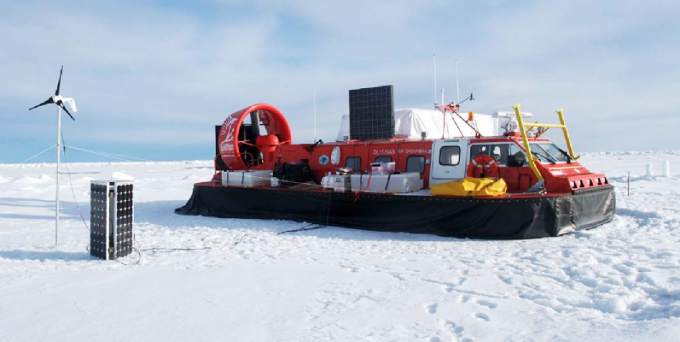Two polar scientists hot on the trail of an arctic mystery have a new tool for exploration: a hovercraft, specially outfitted for week-long trips over the ice with scientific instruments and solar panels.

© Hall and KristoffersonThe hovercraft
Their quarry is a nearly 22,000 square-mile patch of disturbed Arctic sea floor that could be evidence of a massive asteroid strike. John Hall, a now-retired geoscientist, discovered the anomaly during his late-'60s graduate work aboard Fletcher's Ice Island, a huge berg U.S. scientists inhabited for several decades.
Since then, no scientific vessel has been back over the area to collect more data. The massive icebreakers that have crunched through the Arctic since the 1990s can't reach the spot, said Yngve Kristofferson, a scientist and explorer at the University of Bergen in Norway.
Kristofferson became intrigued with Hall's data and in 2004, the two of them met in Bergen to talk Arctic science from eight in the morning to 10 in the evening. At the end of their time together, they came to a decision: They needed a hovercraft.
Luckily, Hall is a partial heir to the fortune his grandfather made as head of the American Chicle Company, the trust that ran the American bubble gum game early in the 20th century, so he was able to buy the vehicle with private funds. A customized Griffon Hovercraft 2000TD, it is now going through the paces, hitting the Arctic from its home at Longyearbyen for the first time in 2008, and hoping to reach its full potential next spring.
Hall delivered a speech detailing the craft's capabilities and mission at Columbia University's Lamont Doherty Earth Observatory on Oct. 6.
"The neat thing with a hovercraft is that you drive with the same ease over 10 centimeter-thick ice as you do with five meter thick ice," Kristofferson told Wired.com.
Despite their futuristic reputation, hovercraft have been commercially available for decades. The concept is actually quite simple. A big engine or turbine pumps air into a rubber skirt that allows the vehicle to tread lightly on whatever it's touching. The R/H Sabvabaa, for example, weighs six tons but exerts no more pressure on any patch of ice than a seagull standing on one leg would by standing on it. The rest of the power from the engine is devoted to propulsion, allowing the craft to skip along at speeds up to 50 miles per hour.
For the strange terrain of the Arctic, it works perfectly, Hall and Kristofferson wrote in an article in the journal
The Leading Edge in August.
"The craft has proved to be useful for a variety of scientific tasks," they wrote. "It appears more efficient than any other platform for ice-thickness measurements and oceanographic work."
Their hovercraft push comes as money has flooded into Arctic research. With Arctic ice melting, the nations adjacent to the ocean are rushing to stake their claims not just on the water, but on the oil and natural gas that lie under the sea floor, leading to calls to establish a National Park to protect the area.
The most fascinating target for the hovercraft is the area of very thick ice closer to Ellesmere Island and northern Greenland. Not even nuclear-powered icebreakers have ventured into the region. It was just Hall's good fortune to have been aboard the floating ice island doing research when it passed near this apparent sea floor anomaly. The duo, along with several other colleagues, described the discovery in a 2008 paper in the
Norwegian Journal of Geology.

© Hall and KristoffersonFletcher’s Ice Island Camp
"The upper couple hundred meters of sediment at the bottom of the Arctic Ocean is just like a carpet that is draped over the topography except for these areas where 150 meters are just blown away and the seabed is severely deformed," Kristofferson said.
To Kristofferson and Hall, the evidence suggests that a pressure wave caused by a pieces of a large asteroid crashing into the Arctic Ocean created these strange features.
"Our working hypothesis is that the spectrum and scale of the observed disturbances are best explained as the effect of a shock wave generated by the impact of an extraterrestrial object," they wrote.
But the hypothesis remains just that without more data. The hovercraft works well, but with its on-board fuel, its range is limited to around 500 miles. For that reason, the scientists imagine they'll use a larger vessel as a base of operations.
"What we really want to do is go along with an icebreaker into the Arctic. You can greatly enhance the scientific output if you have a hovercraft. If you have more of them, even better," Kristofferson said. "We can go out and do our own science and be away for many days. If the icebreaker gets stuck, we're not stuck."
Still, both Hall and Kristofferson know they face an uphill battle to get other scientists to take both the hovercraft and asteroid impact ideas seriously.
"The task is to figure out the real message in the data - the dream challenge for any scientist," Kristofferson told the Lamont Doherty alumni magazine earlier this year. "So far, we have mostly met shaking heads, which just makes it more fun."
Reader Comments
to our Newsletter